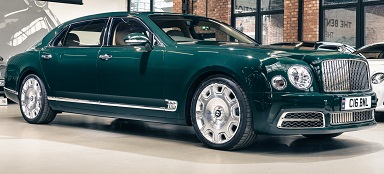

Sedan, 4 Doors, 4 Seats
14.6 l/100 km 16.11 US mpg
22.8 l/100 km 10.32 US mpg
9.9 l/100 km 23.76 US mpg
512 Hp @ 4000 rpm.
75.8 Hp/l
296 km/h 183.93 mph
6752 cm3
412.03 cu. in.
8, V-engine
Rear wheel drive,
5825 mm
229.33 in.
#N/D
2730 kg
6018.62 lbs.
| Brand | Bentley |
|---|---|
| Model | Mulsanne (Sedan) |
| Version | Mulsanne Long |
| Engine version | 6.75 V8 (512 Hp) Automatic |
| Year production start | 2016 |
| Year production end | 2020 |
| Vehicle type | Sedan |
| Horsepower RPM | 512 Hp @ 4000 rpm. |
| Acceleration 0 - 100 kmh sec | 5.5 sec |
| Curb weight kg -lbs total |
2730 kg6018.62 lbs. |
| Overall length mm - inch |
5825 mm229.33 in. |
| Doors | 4 |
| Top Speed | 296 km/h 183.93 mph |
| Designation model | CZMB |
|---|---|
| Engine position and orientation | Front, Longitudinal |
| Cylinders | 8 |
| Position of cylinders | V-engine |
| Displacement (liters) |
6752 cm3412.03 cu. in. |
| Eng. horsepower RPM | 512 Hp @ 4000 rpm. |
| Horsepower per litre | 75.8 Hp/l |
| Weight / horsepower kg/hp - hp/tons |
5.3 kg/Hp187.5 Hp/tonne |
| Weight / torque kg/Nm - Nm/tons | 2.7 kg/Nm, 373.6 Nm/tonne
2.7 kg/Nm373.6 Nm/tonne |
| Torque Nm RPM lb-ft RPM |
1020 Nm @ 1750 rpm.752.31 lb.-ft. @ 1750 rpm. |
| Fuel type | Petrol (Gasoline) |
| Valvetrain | 2 |
| Engine aspiration | Twin-Turbo, Intercooler |
| Engine oil liters | quarts |
9.4 l9.93 US qt | 8.27 UK qt |
| Engine coolant |
20 l21.13 US qt | 17.6 UK qt |
| Emission certification | Euro 6 |
| Powertrain architecture | Internal Combustion engine |
| Engine location | Front, Longitudinal |
| Drive configuration | Rear wheel drive |
|---|
| Front brakes | Ventilated discs |
|---|---|
| Rear brakes | Ventilated discs |
| Brake control | Ventilated discs |
| Anti-lock brake system | ABS (Anti-lock braking system) |
| Steering type | Steering rack and pinion |
|---|
| Rear suspension | Pneumatic suspension |
|---|
| Passengers seats | 4 |
|---|---|
| Trunk space min liter | cu. Ft. |
446 l15.75 cu. ft. |
| Overall length mm - inch |
5825 mm229.33 in. |
|---|---|
| Overall height mm -inch |
1541 mm60.67 in. |
| Wheelbase mm - inch |
3516 mm138.43 in. |
| Track width front mm - inch |
1605 mm63.19 in. |
| Track width rear mm - inch |
1651 mm65 in. |
| Curb weight kg -lbs total |
2730 kg6018.62 lbs. |
|---|---|
| Gross weight kg -lbs total |
3200 kg7054.79 lbs. |
| Capacities kg - lbs |
470 kg1036.17 lbs. |
| Fuel tank liters | gallons |
96 l25.36 US gal | 21.12 UK gal |
| City l/100km - mpg |
22.8 l/100 km10.32 US mpg |
|---|---|
| Highway l/100 km - mpg |
9.9 l/100 km23.76 US mpg |
| Combined l/100 km - Mpg |
14.6 l/100 km16.11 US mpg |
| Autonomy km (combined use) | 686 |
8 CYLINDER V-Engine
https://www.thecarspec.net/components/engine/8-cylinders-v